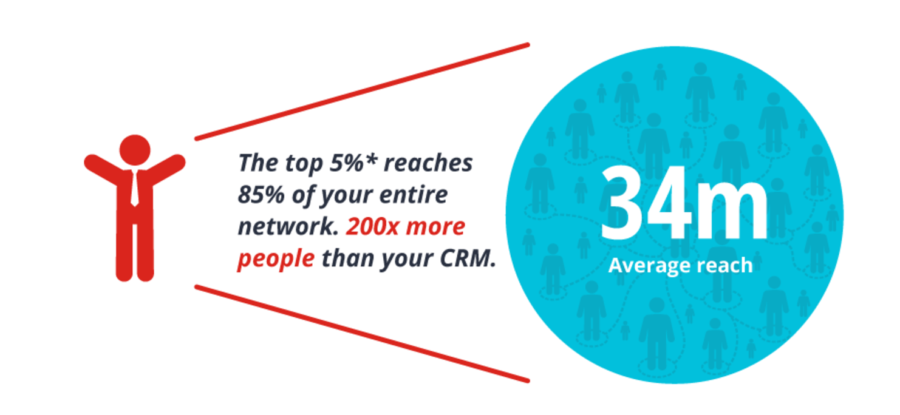Author: Jeanette Russell / Source: Business 2 Community Social media influencers aren’t elusive. They’re everywhere, especially in your em
Social media influencers aren’t elusive. They’re everywhere, especially in your email list. There’s a good chance you have hundreds, if not thousands, who would gladly share your campaign message with their social networks if you did one thing—asked them (and not in a wimpy “p.s. can you share this” kind of way)!
The key to engaging social media influencers at scale (especially if they are already on your email list) is to treat them as a distinct segment. This small but powerful group can offer something of extreme value to your campaigns— social wealth!
The problem is that most organizations have no idea which of their supporters are socially influential. Our quick guide breaks down how you can find the people who are best positioned to share your campaign on social media, so that you can cultivate them to share on behalf of your cause.
This Quick Guide Includes:
- Why your campaigns need influencer marketing
- 3 types of social media influencers and how social scoring works
- Examples of how influencers drive engagement
- What to include in your email to influencers (and what not to send)
Why Your Campaigns Need Influencer Marketing
Social currency is real. We live in an era where the power of an individual or organization is determined in part by their influence online.
One of the main reasons you should get serious about influencer marketing is because you have supporters in your database who could be extending the reach of your campaign to hundreds or thousands of new supporters. This could be exponentially more impactful than asking your supporters to take one-off actions.
Attentive.ly® found when evaluating 90 nonprofit customers that the top 5% of influencers on a nonprofits email list of 140,000 can reach an average of 34 million people, or 85% the total reach of email and Twitter combined.

That’s big deal! And it points to a major untapped opportunity for nonprofits to get their message read and spread by people who may be even better messengers. The Georgetown Digital Persuasion Study reports that 65% find out about a cause through their friends and family, while 68% were prompted to donate after engaging with a cause on social media
In short, you need to cultivate your influencers because 1) you already have them, 2) they can reach a ton of people for your next event, fundraiser, etc. and 3) they are often better messengers.
Social Scoring Helps Find the Best Influencers
Like traditional wealth, social wealth can also be measured. The number of likes, followers, shares, active social networks, and dozens of other interactions can determine how likely it is that a person, or brand, can influence others to take action.
While there are different types of scoring methodologies such as Klout’s rigorous algorithm which assigns a score between 1-100 based on one’s social influence, the most important factors to understand when scoring influence are:
- Reach / # Followers
- Engagement of followers
- Relevancy
- Post frequency
- Relationship with organization

It’s worth noting that the term “score” is more of a way to think about segmentation rather than a standard methodology. Scoring takes many forms ranging from creating your own custom formula to choosing from a pre-scored “VIP, Media, Everyday” type of influencer.
3 Types of Social Influencers You Need to Cultivate
Often, we think of “influencers” as celebrities who could massively raise the visibility of a campaign, but are nearly impossible to recruit if they aren’t already involved with an organization. Both are largely true, which is why it’s important to expand the types of influencers in your marketing mix.
We recommend including different types of messengers such as the media (aka self-identified bloggers) who can write about your issues and “everyday” advocates who can share your message to their networks.
While influencers come in all shapes and sizes, they all have one thing in common: they help drive action by generating buzz around key moments like giving days, report launches, peer-to-peer events, election days, campaign kick-offs etc.
The first step in cultivating these powerful messengers is to segment them into 3 main categories—VIP’s, Media, and Everyday influencers— because each group requires a specific approach and ask.
Solutions like Luminate Online (Beta) and Attentive.ly bake in “social scoring” which allows you to easily find your VIP, Media and Everyday influencers so you can email them about your campaigns.
1. Everyday Influencer

Motivated by passion of a cause, everyday influencers are the largest and most accessible of the three groups to cultivate. These are the “everyday” people in your email list who are often overlooked because they don’t have tremendous individual reach—but as a group they can be powerful.
Example of Everyday influencer:
Cynthia Mackey is an industrial engineer and tireless volunteer for STEM in schools and often uses her social media accounts with over 2,000 Twitter followers to help raise awareness. There tons of people like Cynthia who advocate for issues outside…

COMMENTS